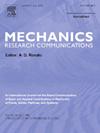均匀分布点支承的正交各向异性矩形板的基频:在设计程序中的应用
IF 2.3
4区 工程技术
Q3 MECHANICS
引用次数: 0
摘要
本文给出了确定均布点支承矩形正交各向异性板振动基频问题的解析解。在板的每个支撑点上,切线的挠度和两个转角都等于零。板的边缘完全夹紧了。所要求的动力学问题的解决方案被简化为确定在四个角点上支承的板的矩形碎片的振动的基本频率。在这样一个板块碎片的每一个边缘,切线的旋转角度和广义剪切力都为零。采用里兹法求解了平板破片的动力学问题。一个近似的偏转板碎片支持在四角被执行使用三个术语的组合夹紧-夹紧梁函数。里兹方法的实现使三次方程的推导成为可能,从该方程中,角状支承板碎片的期望振动频率随后由卡尔达诺方法确定。利用解析解计算了给定尺寸的正交各向异性板块的振动基频。然后将所得频率与均匀分布点支承的整体板的振动基频进行比较。后者的计算采用有限元法进行。比较表明,整个板块的振动频率略高于其碎片的振动频率。很明显,这些频率之间的差异随着沿板块边缘的碎片数量的增加而减小。本文论证了碎片振动基频值在点支承板设计中的应用。本文章由计算机程序翻译,如有差异,请以英文原文为准。
Fundamental frequency of an orthotropic rectangular plate with uniformly distributed point supports: Application to the design procedure
In the paper an analytical solution to the problem of determining the fundamental frequency of vibrations of a rectangular orthotropic plate with uniformly distributed point supports is obtained. The deflection and the two rotation angles of the tangents are equal to zero at each point of support of the plate. The edges of the plate are fully clamped. The solution to the required dynamic problem is reduced to the determination of the fundamental frequency of vibrations of a rectangular fragment of a plate supported at four corner points. At each of the edges of such a plate fragment, the angle of rotation of the tangent and the generalised shear force are both zero. The solution to the dynamic problem for the plate fragment was obtained by employing the Ritz method. An approximation of the deflection of a plate fragment supported at four corners was performed using a three-term combination of clamped–clamped beam functions. The implementation of the Ritz method enabled the derivation of a cubic equation, from which the desired frequency of vibration of the corned supported plate fragment was subsequently ascertained by the Cardano method. The analytical solution was utilised to calculate the fundamental frequency of vibrations of the orthotropic plate fragment with given sizes. The found frequency was then compared with the fundamental frequency of vibrations of whole plates with uniformly distributed point supports. The calculation of the latter was performed by means of the finite element method. The comparison demonstrated that the fundamental frequency of vibrations of whole plates slightly exceeds the frequency of vibrations of their fragments. It is evident that the discrepancy between these frequencies diminishes as the number of fragments along the edges of the plates increases. The paper demonstrates the use of the value of the fundamental frequency of fragment vibrations in the design of point-supported plates.
求助全文
通过发布文献求助,成功后即可免费获取论文全文。
去求助
来源期刊
CiteScore
4.10
自引率
4.20%
发文量
114
审稿时长
9 months
期刊介绍:
Mechanics Research Communications publishes, as rapidly as possible, peer-reviewed manuscripts of high standards but restricted length. It aims to provide:
• a fast means of communication
• an exchange of ideas among workers in mechanics
• an effective method of bringing new results quickly to the public
• an informal vehicle for the discussion
• of ideas that may still be in the formative stages
The field of Mechanics will be understood to encompass the behavior of continua, fluids, solids, particles and their mixtures. Submissions must contain a strong, novel contribution to the field of mechanics, and ideally should be focused on current issues in the field involving theoretical, experimental and/or applied research, preferably within the broad expertise encompassed by the Board of Associate Editors. Deviations from these areas should be discussed in advance with the Editor-in-Chief.

 求助内容:
求助内容: 应助结果提醒方式:
应助结果提醒方式:


